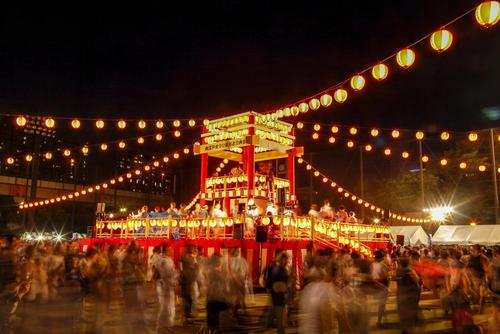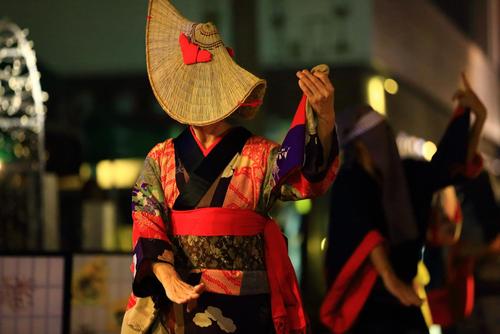Have you ever participated in the Bon Odori dance, one of the summer festival events? Many people may think of Bon Odori as "just a dance," but the original meaning of Bon Odori is to send off the spirits of ancestors who were welcomed during Obon.
In this article, we will introduce the origins of Bon Odori, which even Japanese people are not very familiar with, and how to enjoy it. Whether you have never danced Bon Odori before, or you have danced it before but didn't know its meaning, be sure to read to the end.

First, let me introduce the origins of Bon Odori.
Originated from Buddhist chanting dance
Originally, Bon Odori is an event to welcome the spirits of ancestors who are welcomed during the Obon period, spend time with them, and send them off. Although it is a summer event, it is not just a dance, but a sacred event.
The origin of Bon Odori is said to be the Buddhist "Nenbutsu Dance," which involves dancing while chanting Buddhist prayers, and later developed into "Odori Nembutsu," when the dancers and chanters became separate entities.
These folk performing arts became linked to Obon and became the modern Bon Odori. The dance is performed on August 15th in connection with Obon, and on the 16th, the spirits of ancestors are sent off. It began in the Muromachi period and can be said to be one of the solemn events with a history of about 500 years.
It also has an entertainment element
In addition to showing hospitality to ancestors, Bon Odori also has an element of interaction with local people. This is because people who have left home and are independent return home for the first time in a long time during the Bon Festival, and are able to reunite with old friends and deepen their friendships by dancing and chatting with neighbors.
Also, from the Edo period, it began to function as a place for men and women to meet. In the past, there were hardly any events where many men and women gathered together. For people at that time, it must have felt like dancing their hearts out. The night of the Bon Odori festival (July 15th on the lunar calendar) was a full moon. Even without any lighting, the bright light created an atmosphere that likely made it easy to get excited.
Bon Odori Basics ~How to Do Bon Odori~

Next, we will explain the basics of Bon Odori in detail.
Basically, anyone can participate
Bon Odori is an event that anyone can participate in casually. In some areas, dancers are designated, but in most cases, walk-ins are allowed. As a result, many people join in mid-way, saying, "I didn't feel like dancing at first, but after watching, I wanted to dance."
Bon Odori is a traditional Japanese culture, so it is especially popular with foreign tourists, and is becoming a popular travel activity. Traditionally, people danced to "Ondo" or "folk songs," but recently, they have often danced to "J-pop" or "anime songs." It seems that the dance has been devised so that children and young people can enjoy dancing as well.
The most important thing about Bon Odori is the movement of your feet!
The Bon Odori dance is choreographed with an emphasis on foot movements rather than hand movements. This choreography represents the idea that "people on earth stepping on the ground seal in the spirits of their ancestors who were welcomed during Obon."
Although Bon Odori may look fun, it is also a ceremony to send off ancestors, so it has a slightly sad atmosphere. On the other hand, the dance performed to welcome the spirits as Obon begins is centered around hand movements.
It may seem difficult for first-time dancers, but it's okay to just follow along. Just let yourself get carried away by the "fun yet sad" atmosphere and have fun.
If you attend in a yukata, you'll be even more excited!
You can wear your regular clothes to the Bon Odori dance, but if you want to get into the spirit, why not try wearing a yukata? It will look great in photos and you'll have an even more enjoyable time. By the way, the choreography of the Bon Odori dance is designed to be easy to follow even if you're wearing a yukata, so you won't have any problems moving around in a yukata.
Introducing Bon Odori dances from all over Japan!

Finally, we will introduce the three most famous Bon Odori festivals in Japan, out of all the Bon Odori festivals held throughout the country.
Awa Dance (Tokushima)
It is the largest Bon Odori festival in Japan in terms of the number of dancers, spectators, and scale. It began to be popular among Tokushima merchants during the Bunka-Bunsei era (1804-1830), and has continued to this day.
Dancers dance through the streets of Tokushima accompanied by taiko drums, shamisen, and bamboo flutes. The famous phrase "A fool who dances is a fool who watches, so if you're both fools, you're missing out if you don't dance" is one of the hallmarks of this festival, as the whole of Tokushima is filled with enthusiasm and passion.
Nishimonai Bon Dance (Nishimonai Bon Dance, Akita)
The Nishimonai Bon Odori festival is held every year from August 16th to 18th in Ugo Town, Akita Prefecture. This is an event where people dance together with their ancestors in prayer for a bountiful harvest, and it is highly regarded for its visual artistry. In 1907, haiku poet Kawahigashi Hekigoto wrote in calligraphy that it was "the first time I'd ever seen such a picturesque Bon Odori dance."
Gujo Dance (Gifu)
Bon Odori is a festival that takes place in Gujo City, Gifu Prefecture, from mid-July to early September, and lasts for approximately 32 days (nights). As Obon falls during this period, an all-night dance called the "Ullambana-kai" is held from August 13th to 16th.
It was during the Edo period that Bon Odori began to spread in earnest, incorporating elements of the old dances of the Middle Ages. At the time, it was considered good to dance without regard for class or other distinctions, and so even today, it is a fascinating Bon Odori dance in which locals, tourists, adults and children all dance together in a single circle, without discrimination.
summary
Many of today's younger generations may not know the original meaning of Bon Odori, which is "an event to send off the spirits of ancestors who were welcomed during Obon." However, by learning and deepening their understanding of the meaning and origins, they will be able to enjoy Bon Odori in a different way and realize that it is a culture that should be passed down.
If you come across a Bon Odori dance where the dancers haven't been decided yet, feel free to join in and get a feel for the atmosphere and fun of the occasion.
This article has been partially re-edited by KARUTA from an article originally published on "Nihongo Biyori."
Any unauthorized reproduction or use of the contents, text, images, illustrations, etc. of this website is strictly prohibited.
